A
Auto Express
Guest
The Seven has its roots way back in 1957. Designed originally by Lotus founder Colin Chapman nearly 60 years ago, the first Seven looked similar to how it does today, proving that the recipe has remained pure and true to the car’s original values.
In 1973 Caterham bought the rights to build the Seven and has being doing so ever since, offering buyers a brilliantly British open-top two-seater sports car experience. Over the years the Seven has steadily evolved to deliver more power and performance while retaining the classic looks, but the firm’s timeline hasn’t been without its troubled periods.
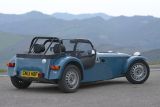
Changing engine suppliers over the years have secured the car’s future, with Ford-sourced power units ensuring Caterham’s most famous model should live on for years to come.
You can choose from a 1.6-litre four-cylinder in the Super Seven 1600, 270 and 310 models or a pair of naturally aspirated 2.0-litre four pots with differing power outputs in the 360 and 420 cars. At the top of the tree sits Caterham’s mad Seven 620 – using a supercharged 2.0-litre Ford engine, this is the fastest Seven ever.
• Best track day cars
Along with these different engine options buyers can also opt for either an S or R pack. The standard S pack adds extra equipment to make the Seven more hospitable for road use, while the R pack costs a further £1,000 and brings with it options that enhance the Caterham’s hardcore focus. However, R models are still great to drive on the road.
All Sevens are open-top two seaters, although you can spec the car in either narrow or SV wide-body form if you want a little more practicality.
As newer, more modern lightweight sports cars and track day specials have hit the market, Caterham’s classic Seven continues to offer something unique – the individual design, connected driving experience and, depending on the version, stunning performance are totally addictive and will leave you wanting more.
The Seven feels quite unlike anything on sale today to drive, for good and bad reasons. The feel and feedback hardwires you into the car, but there’s no getting away from the fact that at times you can also feel a little vulnerable. But when you get it on the right road the Seven makes complete sense.
The Seven is a featherweight, tipping the scales in its lightest form at just 540kg. Even the base 270 version has true sports car pace, delivering 135bhp from its 1.6-litre engine and sprinting from 0-60mph in 5.0 seconds. Although there have been lighter models in the past, this entry-level Seven still boasts incredible agility, responding to flicks of the small steering wheel quickly and precisely.
However, the engine can sometimes feel flat and needs to be revved in the S model, partly due to the longer ratios of the five-speed gearbox. Opt for the 270 or 310 R, with a lightened flywheel, limited-slip differential and sports suspension, and it feels much racier. The firmer suspension dampers mean you’ll feel a little more on bad roads, but it doesn’t compromise the car’s ability unduly, as the Seven carries incredible speed down even poorly surfaced tarmac.
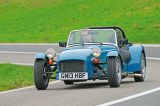
This is ramped up if you opt for one of the 2.0-litre engined cars. With 180bhp the 360 is quick, but it’s the 210bhp 420 version that’ll really set your pulse racing.
The engine is ferocious, offering up a big swell of torque in the mid-range, then it crescendos to a frenzied peak beyond 7,600rpm, where it makes maximum power. Get the start right off the line and the 420 will sprint from 0-60mph in just 3.8 seconds, but with no traction control you’ll have to watch for wheelspin in anything but perfect conditions.
That’s even more important with the 620. The supercharged engine kicks out 310bhp, and at this level, the 620 S with its five-speed gearbox and softer suspension makes for a more usable road car. However, go for the 620 R with the standard six-speed sequential gearbox, and a 0-60mph time of 2.8 seconds is possible.
There is a drawback, though. While R models get the most performance kit, there’s no weather protection, and fixed-back composite bucket seats are standard. If you want softer leather seats, a windscreen, doors and a roof, the S pack includes all these, adding a few other comforts like a heater.
Engines
You have to rev the 270 and 310 S hard, where the R models with their engine and transmission modifications feel much more fluid. Both are still great fun and rewarding to drive, with the side-exit exhaust giving a blare under acceleration and some pops and bangs on the overrun.
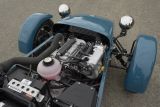
Upgrading to the 360 or 420 adds a lot more performance, and you can feel it from behind the wheel. There’s only 9Nm difference in the cars’ torque outputs (203Nm for the 420, 194Nm in the 360), so both feel urgent in the mid-range, ramping up to a frantic top end – but it’s here the 420’s extra power shows as it takes off with real ferocity.
That’s nothing compared to the way the 620 models rev, though. The supercharger gives monstrous performance, so you don’t have to work the gearbox as hard, but rev the engine out to its red line and you’ll be left slack jawed at just how quick this sports car is.
It’s a visceral thrill as the whine from the supercharger under the bonnet compliments the snort from the exhaust, giving sharp throttle response and a great connection to the car at high revs compared to a turbo unit.
You might not associate a sports car like the Caterham Seven with strong fuel economy, but as the car is so light it doesn’t take much effort to move it around. This means you use less petrol – until you start to explore the performance. And you will, as driving a Seven is an addictive experience.
Around mid 30s to the gallon is a fair bet, but this will drop to low 20s (or even less depending on the model and how you drive) the harder you push the engine.
There are no official fuel economy and CO2 emissions figures for the Caterham range though, because as a low-volume manufacturer the company doesn’t have to carry out the same test as more mainstream brands.
Insurance groups
Similar to efficiency data, the Seven isn’t actually rated in the conventional insurance groups – instead, most insurers will treat each car on a case-by-case basis, giving a price depending on where the car is kept, the age of the driver, how many points they might have on their licence and other factors like what they do for a living.
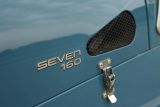
If you opt for a high-performance model, expect cover costs to be fairly steep as security isn’t exactly strong and, with no driver aids and lots of power, an insurer might see the risk as quite high.
Depreciation
Despite some of the impracticalities, there’s still strong demand for the Seven on the used market. That’s partly because the design hasn’t changed all that much over the years, so performance and tech have remained relatively constant – especially for the last decade or so when it comes to the core models at the centre of the Seven line-up.
As a result Caterhams tend to hold their value incredibly well, so while they might seem pricey to buy, you should recoup some of the value if you decide to sell the car on.
There’s a healthy and enthusiastic group of owners that stay in contact with the factory too, so most second-hand cars tend to have been well maintained and looked after.
There’s not much equipment inside a Caterham – even if you go for the more lavish S pack, and we use the term ‘lavish’ loosely. This adds full weather protection, a heater and a heated windscreen, which actually comes in very useful to stop the glass steaming up in the wet.
There’s also a 12V socket mounted under the dashboard, so you can plug in a sat-nav, or with a USB adapter, charge your mobile phone on the move.
The old-school Super Seven 1600 is inspired by the original Super Sevens. The individual interior is available with different leather trims, a wooden-rimmed Moto-Lita wheel and a set of suitably retro Smiths instruments to give you all the vital information.
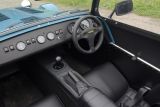
Entry and exit isn’t the easiest, especially with the roof on, but if you opt for the quick release steering wheel it gives you a little more room to fold your legs in. The SV wide body chassis also helps here, making the cabin feel noticeably roomier than the standard S3 chassis.
The heater is effective too, pumping out a solid stream of hot air into the cabin to keep you warm on colder days.
Beyond this there isn’t any equipment – not even a radio – while more hardcore R models don’t even get a heater or a windscreen. Go for the 620 S however, and the option of heated seats is available.
There is 120 litres of boot space available in the Seven, but as the roll bar stays plunge deep into the luggage bay, it does reduce the usable room on offer. There’s more space with the roof up, as you can then load bags higher, but it can reduce rear visibility.
There’s no storage space inside the cabin either, and while you can slip items or narrow bags behind the seats, it’s not exactly a practical solution.
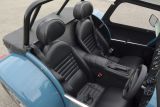
However, it’s actually relatively comfortable with the S pack’s softer dampers and regular seats. It’s still a firm car, but on motorways the ride is acceptable for a sports car with this much performance.
There is a drawback when it comes to the roof, though. It can be awkward to fold the roof frame out of the boot before clipping the vinyl hood onto the windscreen and around the boot area, so if you’re having to do it in a hurry in a downpour, you might get wet.
Another option is available in the form of the half roof, which clips to the front of the windscreen and stretches over the roll bar – it’s much quicker to put on and will keep the rain off, but the downside is the big hole left behind the seats can let some spray in.
Size
The Seven is a compact car, even for a two-seater, so the narrow body means you can thread it through gaps even some superminis won’t be able to get through.
It does bring with it some benefits, like being able to stay in your lane on a country road, while parking the Seven is simple thanks to its modest dimensions and excellent visibility.
Leg room, head room & passenger space
Legroom and headroom are good, and with your legs stretched out in front of you, there’s plenty of space – especially with the wider SV chassis.
The basic design of the Seven hasn’t moved on all that much, so whereas other cars now boast clever crash features like crumple zones and electronic systems to avoid an impact in the first place, the Caterham doesn’t even get an airbag.
Three-point seat belts are standard, although you can opt for race harnesses if you prefer. Stability control and ABS isn’t available, so you’re in total control of the machine – with the higher-powered models in the range you have to be incredibly judicious with the throttle to stop the wheels spinning up. Euro NCAP doesn’t crash test the Caterham, either.
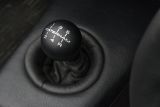
Reliability should be better as there’s not all that much equipment to go wrong. With the Ford-sourced engines the Seven should be reliable, and if any niggles do emerge, the cars are relatively easy to fix.
Warranty
Caterhams only come with a one-year warranty.
Servicing
Caterham's main showroom is in Crawley, but there are a further three official UK retailers in Bristol, Silverstone and Cheshire. Servicing prices are on the higher side, but as the Seven is such a specialist vehicle, it’s important to get it maintained by experts – plus this protects its value in the future.
Continue reading...
In 1973 Caterham bought the rights to build the Seven and has being doing so ever since, offering buyers a brilliantly British open-top two-seater sports car experience. Over the years the Seven has steadily evolved to deliver more power and performance while retaining the classic looks, but the firm’s timeline hasn’t been without its troubled periods.

Changing engine suppliers over the years have secured the car’s future, with Ford-sourced power units ensuring Caterham’s most famous model should live on for years to come.
You can choose from a 1.6-litre four-cylinder in the Super Seven 1600, 270 and 310 models or a pair of naturally aspirated 2.0-litre four pots with differing power outputs in the 360 and 420 cars. At the top of the tree sits Caterham’s mad Seven 620 – using a supercharged 2.0-litre Ford engine, this is the fastest Seven ever.
• Best track day cars
Along with these different engine options buyers can also opt for either an S or R pack. The standard S pack adds extra equipment to make the Seven more hospitable for road use, while the R pack costs a further £1,000 and brings with it options that enhance the Caterham’s hardcore focus. However, R models are still great to drive on the road.
All Sevens are open-top two seaters, although you can spec the car in either narrow or SV wide-body form if you want a little more practicality.
As newer, more modern lightweight sports cars and track day specials have hit the market, Caterham’s classic Seven continues to offer something unique – the individual design, connected driving experience and, depending on the version, stunning performance are totally addictive and will leave you wanting more.
The Seven feels quite unlike anything on sale today to drive, for good and bad reasons. The feel and feedback hardwires you into the car, but there’s no getting away from the fact that at times you can also feel a little vulnerable. But when you get it on the right road the Seven makes complete sense.
The Seven is a featherweight, tipping the scales in its lightest form at just 540kg. Even the base 270 version has true sports car pace, delivering 135bhp from its 1.6-litre engine and sprinting from 0-60mph in 5.0 seconds. Although there have been lighter models in the past, this entry-level Seven still boasts incredible agility, responding to flicks of the small steering wheel quickly and precisely.
However, the engine can sometimes feel flat and needs to be revved in the S model, partly due to the longer ratios of the five-speed gearbox. Opt for the 270 or 310 R, with a lightened flywheel, limited-slip differential and sports suspension, and it feels much racier. The firmer suspension dampers mean you’ll feel a little more on bad roads, but it doesn’t compromise the car’s ability unduly, as the Seven carries incredible speed down even poorly surfaced tarmac.

This is ramped up if you opt for one of the 2.0-litre engined cars. With 180bhp the 360 is quick, but it’s the 210bhp 420 version that’ll really set your pulse racing.
The engine is ferocious, offering up a big swell of torque in the mid-range, then it crescendos to a frenzied peak beyond 7,600rpm, where it makes maximum power. Get the start right off the line and the 420 will sprint from 0-60mph in just 3.8 seconds, but with no traction control you’ll have to watch for wheelspin in anything but perfect conditions.
That’s even more important with the 620. The supercharged engine kicks out 310bhp, and at this level, the 620 S with its five-speed gearbox and softer suspension makes for a more usable road car. However, go for the 620 R with the standard six-speed sequential gearbox, and a 0-60mph time of 2.8 seconds is possible.
There is a drawback, though. While R models get the most performance kit, there’s no weather protection, and fixed-back composite bucket seats are standard. If you want softer leather seats, a windscreen, doors and a roof, the S pack includes all these, adding a few other comforts like a heater.
Engines
You have to rev the 270 and 310 S hard, where the R models with their engine and transmission modifications feel much more fluid. Both are still great fun and rewarding to drive, with the side-exit exhaust giving a blare under acceleration and some pops and bangs on the overrun.

Upgrading to the 360 or 420 adds a lot more performance, and you can feel it from behind the wheel. There’s only 9Nm difference in the cars’ torque outputs (203Nm for the 420, 194Nm in the 360), so both feel urgent in the mid-range, ramping up to a frantic top end – but it’s here the 420’s extra power shows as it takes off with real ferocity.
That’s nothing compared to the way the 620 models rev, though. The supercharger gives monstrous performance, so you don’t have to work the gearbox as hard, but rev the engine out to its red line and you’ll be left slack jawed at just how quick this sports car is.
It’s a visceral thrill as the whine from the supercharger under the bonnet compliments the snort from the exhaust, giving sharp throttle response and a great connection to the car at high revs compared to a turbo unit.
You might not associate a sports car like the Caterham Seven with strong fuel economy, but as the car is so light it doesn’t take much effort to move it around. This means you use less petrol – until you start to explore the performance. And you will, as driving a Seven is an addictive experience.
Around mid 30s to the gallon is a fair bet, but this will drop to low 20s (or even less depending on the model and how you drive) the harder you push the engine.
There are no official fuel economy and CO2 emissions figures for the Caterham range though, because as a low-volume manufacturer the company doesn’t have to carry out the same test as more mainstream brands.
Insurance groups
Similar to efficiency data, the Seven isn’t actually rated in the conventional insurance groups – instead, most insurers will treat each car on a case-by-case basis, giving a price depending on where the car is kept, the age of the driver, how many points they might have on their licence and other factors like what they do for a living.

If you opt for a high-performance model, expect cover costs to be fairly steep as security isn’t exactly strong and, with no driver aids and lots of power, an insurer might see the risk as quite high.
Depreciation
Despite some of the impracticalities, there’s still strong demand for the Seven on the used market. That’s partly because the design hasn’t changed all that much over the years, so performance and tech have remained relatively constant – especially for the last decade or so when it comes to the core models at the centre of the Seven line-up.
As a result Caterhams tend to hold their value incredibly well, so while they might seem pricey to buy, you should recoup some of the value if you decide to sell the car on.
There’s a healthy and enthusiastic group of owners that stay in contact with the factory too, so most second-hand cars tend to have been well maintained and looked after.
There’s not much equipment inside a Caterham – even if you go for the more lavish S pack, and we use the term ‘lavish’ loosely. This adds full weather protection, a heater and a heated windscreen, which actually comes in very useful to stop the glass steaming up in the wet.
There’s also a 12V socket mounted under the dashboard, so you can plug in a sat-nav, or with a USB adapter, charge your mobile phone on the move.
The old-school Super Seven 1600 is inspired by the original Super Sevens. The individual interior is available with different leather trims, a wooden-rimmed Moto-Lita wheel and a set of suitably retro Smiths instruments to give you all the vital information.

Entry and exit isn’t the easiest, especially with the roof on, but if you opt for the quick release steering wheel it gives you a little more room to fold your legs in. The SV wide body chassis also helps here, making the cabin feel noticeably roomier than the standard S3 chassis.
The heater is effective too, pumping out a solid stream of hot air into the cabin to keep you warm on colder days.
Beyond this there isn’t any equipment – not even a radio – while more hardcore R models don’t even get a heater or a windscreen. Go for the 620 S however, and the option of heated seats is available.
There is 120 litres of boot space available in the Seven, but as the roll bar stays plunge deep into the luggage bay, it does reduce the usable room on offer. There’s more space with the roof up, as you can then load bags higher, but it can reduce rear visibility.
There’s no storage space inside the cabin either, and while you can slip items or narrow bags behind the seats, it’s not exactly a practical solution.

However, it’s actually relatively comfortable with the S pack’s softer dampers and regular seats. It’s still a firm car, but on motorways the ride is acceptable for a sports car with this much performance.
There is a drawback when it comes to the roof, though. It can be awkward to fold the roof frame out of the boot before clipping the vinyl hood onto the windscreen and around the boot area, so if you’re having to do it in a hurry in a downpour, you might get wet.
Another option is available in the form of the half roof, which clips to the front of the windscreen and stretches over the roll bar – it’s much quicker to put on and will keep the rain off, but the downside is the big hole left behind the seats can let some spray in.
Size
The Seven is a compact car, even for a two-seater, so the narrow body means you can thread it through gaps even some superminis won’t be able to get through.
It does bring with it some benefits, like being able to stay in your lane on a country road, while parking the Seven is simple thanks to its modest dimensions and excellent visibility.
Leg room, head room & passenger space
Legroom and headroom are good, and with your legs stretched out in front of you, there’s plenty of space – especially with the wider SV chassis.
The basic design of the Seven hasn’t moved on all that much, so whereas other cars now boast clever crash features like crumple zones and electronic systems to avoid an impact in the first place, the Caterham doesn’t even get an airbag.
Three-point seat belts are standard, although you can opt for race harnesses if you prefer. Stability control and ABS isn’t available, so you’re in total control of the machine – with the higher-powered models in the range you have to be incredibly judicious with the throttle to stop the wheels spinning up. Euro NCAP doesn’t crash test the Caterham, either.

Reliability should be better as there’s not all that much equipment to go wrong. With the Ford-sourced engines the Seven should be reliable, and if any niggles do emerge, the cars are relatively easy to fix.
Warranty
Caterhams only come with a one-year warranty.
Servicing
Caterham's main showroom is in Crawley, but there are a further three official UK retailers in Bristol, Silverstone and Cheshire. Servicing prices are on the higher side, but as the Seven is such a specialist vehicle, it’s important to get it maintained by experts – plus this protects its value in the future.
Continue reading...
